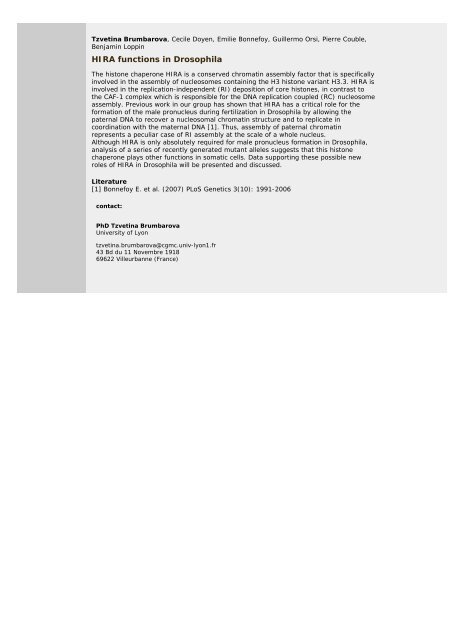Abstracts (poster) - Wissenschaft Online
Abstracts (poster) - Wissenschaft Online
Abstracts (poster) - Wissenschaft Online
Create successful ePaper yourself
Turn your PDF publications into a flip-book with our unique Google optimized e-Paper software.
Tzvetina Brumbarova, Cecile Doyen, Emilie Bonnefoy, Guillermo Orsi, Pierre Couble,<br />
Benjamin Loppin<br />
HIRA functions in Drosophila<br />
The histone chaperone HIRA is a conserved chromatin assembly factor that is specifically<br />
involved in the assembly of nucleosomes containing the H3 histone variant H3.3. HIRA is<br />
involved in the replication-independent (RI) deposition of core histones, in contrast to<br />
the CAF-1 complex which is responsible for the DNA replication coupled (RC) nucleosome<br />
assembly. Previous work in our group has shown that HIRA has a critical role for the<br />
formation of the male pronucleus during fertilization in Drosophila by allowing the<br />
paternal DNA to recover a nucleosomal chromatin structure and to replicate in<br />
coordination with the maternal DNA [1]. Thus, assembly of paternal chromatin<br />
represents a peculiar case of RI assembly at the scale of a whole nucleus.<br />
Although HIRA is only absolutely required for male pronucleus formation in Drosophila,<br />
analysis of a series of recently generated mutant alleles suggests that this histone<br />
chaperone plays other functions in somatic cells. Data supporting these possible new<br />
roles of HIRA in Drosophila will be presented and discussed.<br />
Literature<br />
[1] Bonnefoy E. et al. (2007) PLoS Genetics 3(10): 1991-2006<br />
contact:<br />
PhD Tzvetina Brumbarova<br />
University of Lyon<br />
tzvetina.brumbarova@cgmc.univ-lyon1.fr<br />
43 Bd du 11 Novembre 1918<br />
69622 Villeurbanne (France)

















